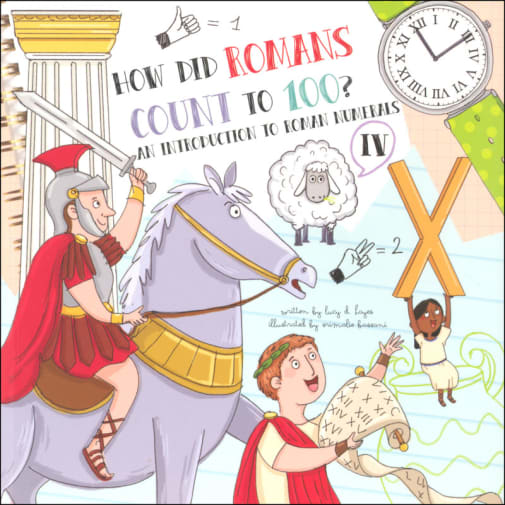What child won’t enjoy solving “Gladiator math” problems! Students learn to count their way as cheery Romans of all ages teach the “special code” and the 4 rules to use them in math problems. Children gain this skill through special activities (with toothpicks, decoding, etc.) and mnemonics to recall what symbol means what. Practice counting sheep and other numeral math problems in the numerals. FYI: no gladiator violence displayed in this production! 8”x 8” text. 32 pgs, hc. ~ Ruth
How Did Romans Count to 100?
Description
Have you ever wondered how people counted to 100 before modern numbers were invented?
In the How Do series, readers are invited to guess and then explore the science behind the right answers. A basic explanation of Roman numerals, examples of how they are used today, and step-by-step guides on how to use them are explored through diagrams, photos, and informative and engaging text in this newest addition to the How Do series.
The 3rd edition has been completely revised compared to the 1st and 2nd editions. Maintaining a Creation focused, rigorous approach to the sciences, the updated content changes are a more natural progression of Apologia's upper level scope and sequence that began with the General Science, 3rd edition. A careful introduction to the scientific process, methods, and measurement/data collection are covered in the first module, followed by a focus on chemistry (4 modules) and physics (6 modules). Additional chapters cover earth science (2 modules), and chemistry and physics in the life sciences. Physical Science Research concludes the course, showing students what is involved in research from brainstorming to making a presentation. A total of 15 modules are included, and will take 2 or more weeks to complete. Students should plan on spending one hour per day on science. Like the previous courses, the text is written to the student and most students will be able to complete the readings and most activities independently. Labs are integral, with 29 formal experiments and 47 "Explore More" activities included. Hands-on experiments use household supplies. Safety glasses are required. For your convenience, a Nature's Workshop Plus Lab Kit is available. Students will learn how to create both informal and formal lab reports in this course. Completion of all lab activities are expected, and students will document all labs through either the informal or formal report. One formal lab report is completed per module. Not compatible with the previous edition.
There are 2 required components. First is the softcover Student Text which includes all student reading, experiments, "On Your Own" exercises (with answers and discussion later in the chapter), and Study Guide questions at the end of each chapter. The second book, Solutions and Tests, contains the chapter test booklet, answers to the test questions and solutions to the "Study Guide" questions. Tests are not reproducible. Test booklets can be purchased separately.
Optional but recommended, the Student Notebook, provides a suggested daily schedule, a place to record study notes, lab charts and tables and space to answer the "On Your Own" and Study Guide questions. Not reproducible. Also available, the optional Audio MP3 CD provides an audio reading of the textual information and "On Your Own" questions.
| Product Format: | Paperback |
|---|---|
| Grades: | 2-5 |
| Brand: | Flowerpot Press |
| ISBN: | 9781486725588 |
| Length in Inches: | 8 |
| Width in Inches: | 8 |
| Height in Inches: | 0.125 |
| Weight in Pounds: | 0.25 |

